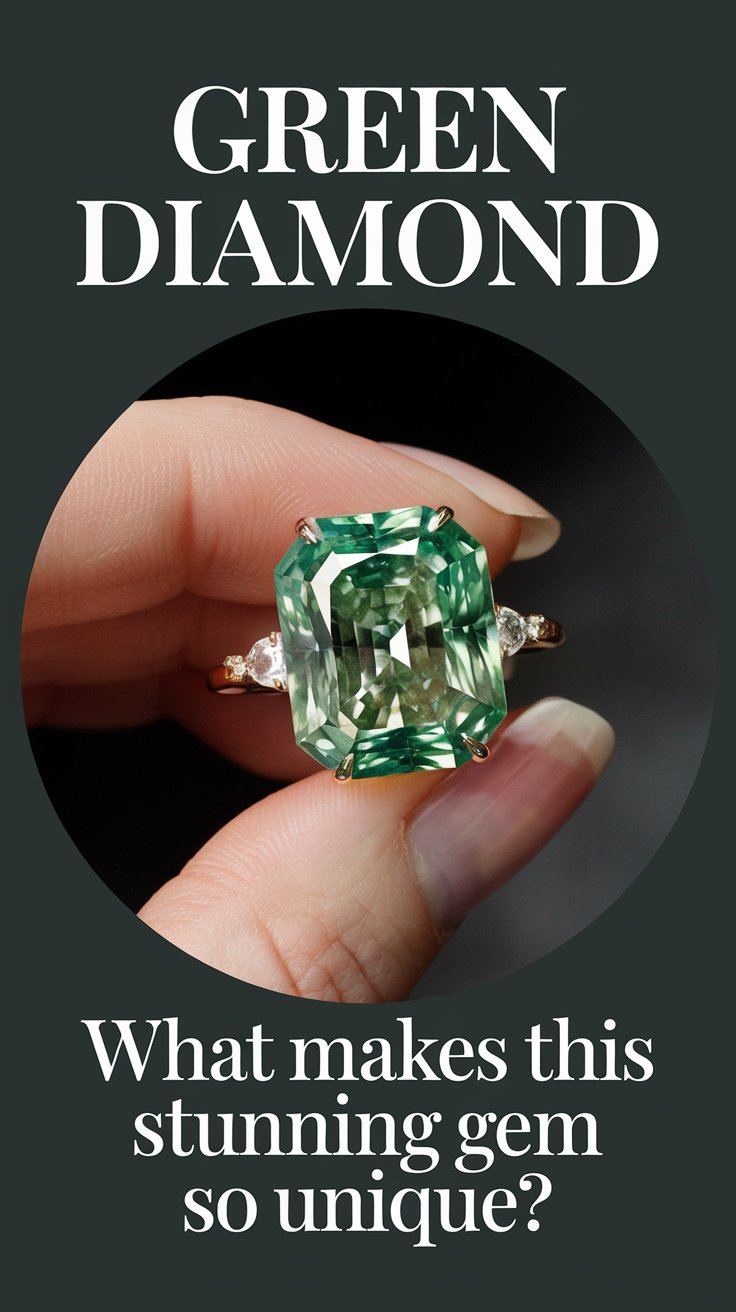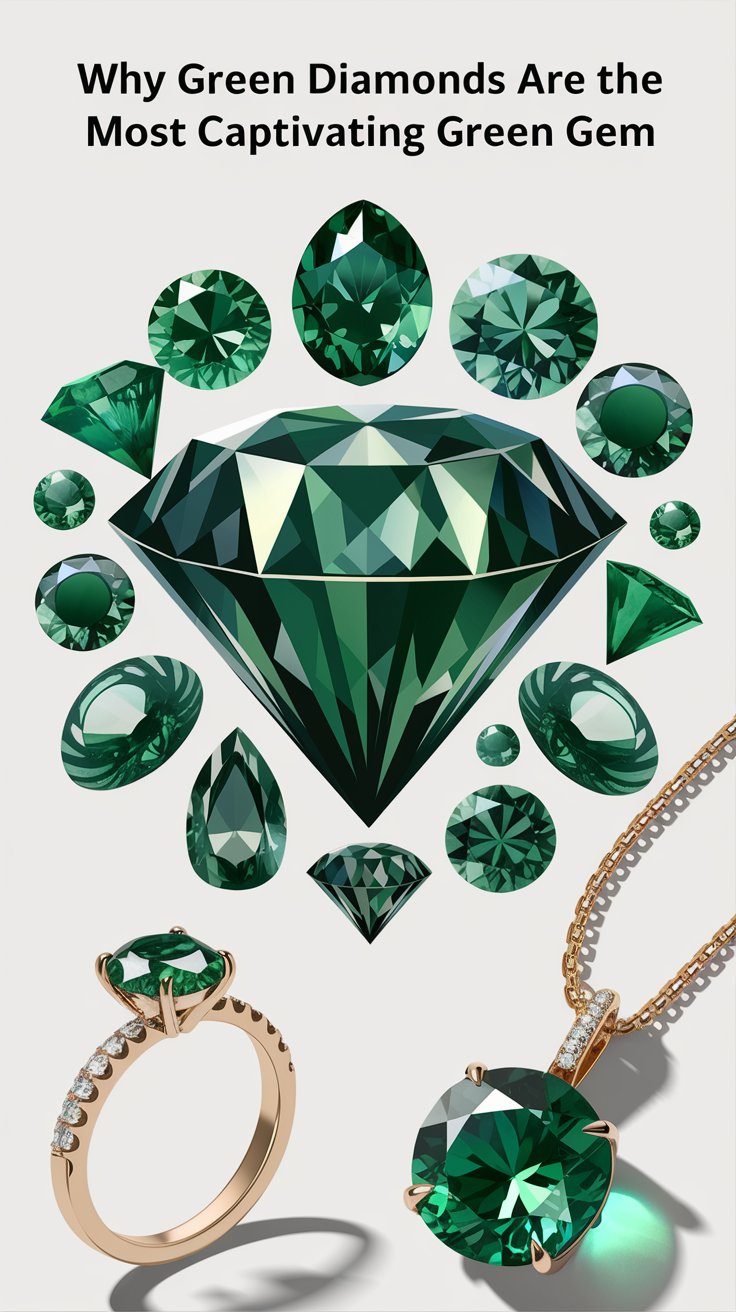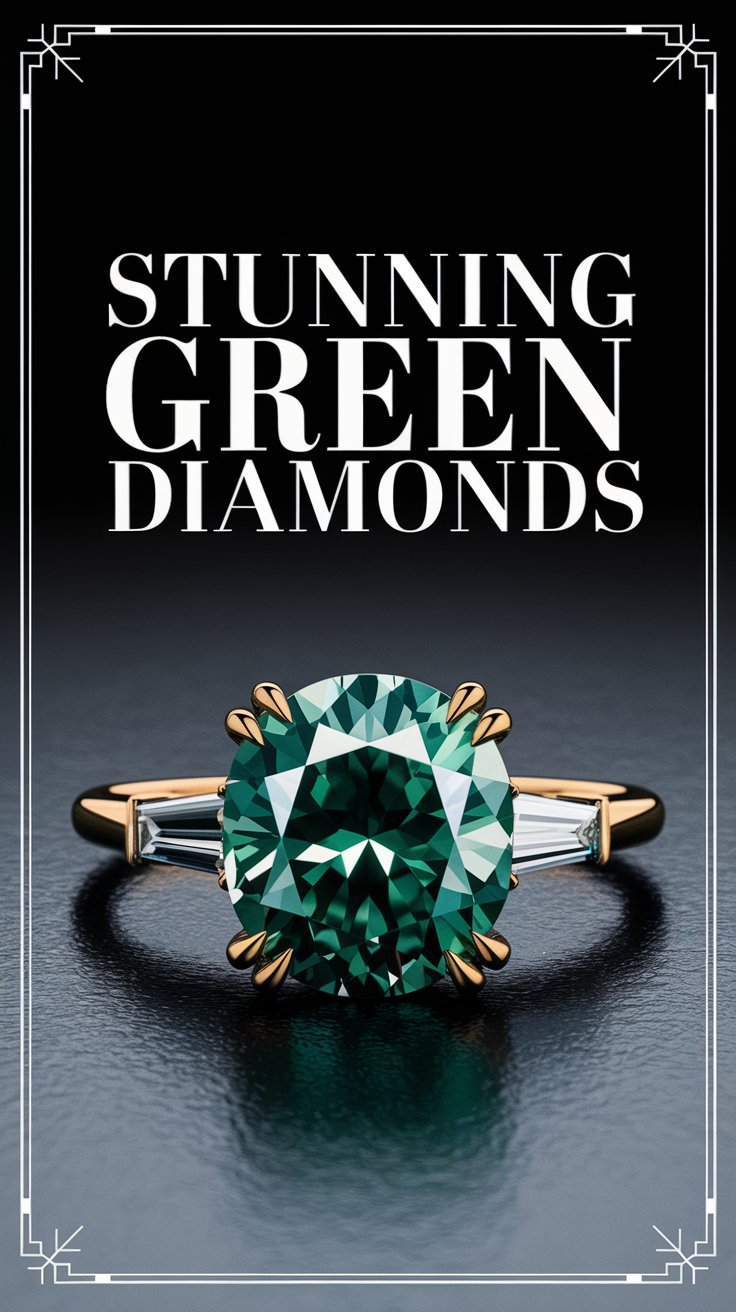Of all the fancy colored diamonds available on the luxury diamond market, green diamonds are perhaps the most enigmatic.
Intriguing both shoppers and gemologists for decades, these curious glittering stones have brought more questions than answers. Green diamonds are one of the rarest types of diamonds and always garner a lot of interest at high-profile auctions.
From their unusual origins just below the center of the earth to the specialized techniques diamond cutters need to use just for these particular gems, green diamonds are truly a unique treasure. They offer jewelry lovers something they won’t find anywhere else, and they help gemologists learn and grow in their craft.
Let’s take a look at what sets these magnificent gems apart.
 Pin
Pin Pin
Pin Pin
PinWhat Is a Green Diamond?
Green diamonds are unusual, to say the least. While most colored diamonds get their unique colorations from either mineral impurities or deviations in the growth patterns of the stone, green diamonds get their color from something else entirely: radiation.
Back in the 1960s when Stan Lee decided that the Incredible Hulk turned green (and incredible) from exposure to gamma radiation, he said it with such a smile and a swagger that nobody questioned the logistics of the idea. He later admitted that he didn’t have a clue what gamma radiation was. It turns out he might have been on to something.
Diamonds that form under the earth’s surface in areas with radiation exposure transform and develop these green colors. Though exceedingly rare, these diamonds have been found mostly in Africa and South America. Diamonds exposed to alpha radiation — the weakest form — will develop a faint color that barely penetrates the surface, which can easily be lost entirely during the cutting process. Diamonds exposed to more intense beta and gamma radiation are more likely to develop deeper, more intense colors.
It took a long time for gemologists to understand what was happening to cause these fantastic emerald-hued gems. Then, in 1904, a man named Sir William Crookes tried burying some diamonds in radioactive salt crystals. This was the beginning of irradiation treatment in the gemstone industry.
Now, most green diamonds that show up on the market have been artificially treated with radiation. There are only a few examples of substantial natural green diamonds throughout history, and we’ll talk about those a bit more down below.
How Can You Tell If a Green Diamond Is Real?
There are a lot of initiation green diamonds on the market, in addition to other natural green stones like emerald, jade, aventurine, malachite… the list goes on. Plus, there are real diamonds whose color has been artificially manufactured. What’s a diamond shopper to do?
Green diamonds are very real diamonds and so will share all of the same geological and optical properties as standard colorless diamonds. They reflect and refract light in a way that no other stone can hope to match, giving the gem its trademark brilliance and sparkle. You can read about some of the tests we can do at home to verify our diamond jewelry.
 Pin
PinWhen it comes to verifying color treatments in diamonds, it’s always a bit tricky – but green diamonds are a special challenge. This is because the process used to create green color in a laboratory is exactly the same as the process that happens within the earth, just on a smaller scale. However, there are a few clues that gemologists can keep an eye out for.
Color Treatment Tells vs. Natural Tones in Green Diamonds
The first and most reliable are radiation stains, which look a little like green burn marks that have been left on the surface of the stone by the radiation exposure. Sometimes these marks are lost during the cutting process, but often diamond cutters will try to leave a little bit of staining along the girdle (that’s the “belt” that runs around the middle of the stone). This is done for two reasons: to help intensify the color, and to aid in verifying the natural origin of the color later.
When these radiation stains are not present, identifying a real green diamond can be a little more difficult. Both naturally colored and color treated green diamonds can have inconsistent washes of color, but having a lot of color concentrated right at the culet (that’s the point at the very bottom) strongly suggests treatment.
An older form of color irradiation called “cyclotron irradiation” creates what’s known as an umbrella effect (and no, it’s not a dysfunctional family of super powered siblings). This is where a concentration of green color spreads up the bottom of the diamond from the culet in an umbrella shape.
Because the earth’s radiation is inconsistent, most natural green diamonds won’t show a uniform color all the way through — there will be lighter and darker areas, and the color will gather together mostly at the surface. Artificially colored green diamonds are more likely to be a solid, beautiful green all the way through. However, this isn’t always the case.
A Rare Outlier
You’ll read a little more about some famous green diamonds below, including the Dresden Green. We know for absolutely certain that this is a naturally colored diamond because it’s been circulating through the jewelry world since the 1700s, far before the earliest irradiation techniques.
And yet, in 1988 this stone was examined by gemologists from the GIA and they were forced to admit that, had they no prior knowledge of the stone’s origins, they probably would have guessed it to be color treated.
The Dresden Green is a very rare example in that the green color is rich and uniform throughout the entire stone, due to a perfect confluence of natural wonder. There is still much in the world even trained scientists don’t yet understand, though we are always trying to learn more. The GIA is constantly examining both known natural and treated green diamonds to try and improve their understanding of identifying treatments in these stones.
How Do You Determine the Quality of a Green Diamond?
Like other colored diamonds, green diamonds are graded on a color scale from Faint, Very Light, Light, Fancy Light, Fancy, Fancy Intense, Fancy Vivid to Fancy Deep. Generally, the more rich, intense, and uniform the color, the more valuable the gem will be. In particular, unusual color combinations such as blue and green together (like the Ocean Dream, below) will fetch the highest prices.
Apart from color, the value of green diamonds is impacted by the same grading factors as any other natural diamond, whether it’s a fancy colored or colorless diamond: cut, clarity, and carat weight.
Cut
Cut is particularly essential to green diamonds because so much of the color tends to be concentrated at the surface of the stone. This is a challenge for diamond cutters, who want to get the most beautiful proportions to optimize the play of light while retaining as much of the surface color as possible. The girdle is often the best place to leave some of the natural surface of the stone behind which will be reflected throughout the gem.
Clarity
While the clarity grade does impact the value of the diamond, it’s less highly prioritized in colored diamonds. This is because fancy colored diamonds are so rare that even highly included stones are an exciting find.
When fashioning standard colorless diamonds, cutters do their best to get the highest quality stone possible and will often cut around inclusions and blemishes to increase the clarity grade. In colored stones, however, the priority is retaining as much of the color as possible. For this reason they may sacrifice the clarity grade to ensure a more intense color.
Carat Weight
Compared to other colored diamonds, green diamonds are one of the rarest colors you can find. Though relatively uncommon in high-profile auctions, when they do appear they can come with price tags of millions of dollars per carat. Natural green diamonds begin at around $20,000 for a 1ct. stone, dependent on other quality factors.
How Do You Care For a Green Diamond?
Although diamonds are unmatchably hard, it is possible for them to chip if dropped or knocked against something — particularly if the diamond is of a lower clarity grade, as inclusions can interfere with the structural integrity of the stone.
Extra care should be taken with natural green diamonds since the color is so concentrated at the surface. If you were to chip an area at the outer edge that held a lot of color, less would be reflected through the stone and the entire body color could suffer as a result. This would drastically lower the overall value of the diamond.
For this reason, it’s best to have green diamonds carefully protected in a setting that guards the points and edges against external damage. It should be gently cleaned with a soft cloth, rather than machines.
What Are Some Famous Green Diamonds?
For most of us, fancy green diamonds are pretty far outside of the engagement ring budget. But the rare, captivating beauties are still fun to read about (and drool over). Especially some of these famous green diamonds, complete with cool names and rich histories.
The Dresden Green
The Dresden Green diamond is the most famous natural green diamond in fine jewelry history — it weighs about 41 carats and first appeared in London in 1726. For a while it was set in a special badge for the “Order of the Golden Fleece” (to “encourage and reward virtue and faith among men of high lineage”), before the badge was disassembled and the Dresden was reset into a hat ornament. This ornament still exists — you can see it in the Green Vault Museum in Dresden, Germany. This gem is one of the highest quality natural green diamonds ever found.
The Aurora Green
The Aurora Green is a natural green diamond just over five carats that sold for $16.8m ($3.3m per carat) in 2016. It’s set into a ring surrounded by pink diamonds and is the most expensive green diamond ever sold.
The Ocean Dream
The Ocean Dream diamond is an extraordinary example of diamond color. Graded as Fancy Vivid Blue-Green, this is a rare teal-colored stone reminiscent of the Pacific. The unique hue came from a combination of radiation exposure and just the right balance of trace boron minerals in the gem. It is just over five and a half carats and is considered one of the rarest diamonds on earth.
The Chopard Chameleon
The Chopard Chameleon diamond is a famous example of one of nature’s more extraordinary creations – chameleon diamonds. These diamonds sound like something from a sci-fi novel, but they are in fact a very real phenomenon: diamonds that change color depending on their ambient temperature. This 31ct chameleon diamond shifts between olive green and brassy yellow and is the largest, highest quality example of this type of diamond ever found.
Green Diamond FAQ
Green colored diamonds have a very fresh, youthful energy to them, like the first new grass of springtime. They symbolize clarity and new beginnings.
Despite having similar colorations, diamonds and emeralds are different stones with completely different geological structures. In general, emeralds are more fragile than diamonds and don’t refract light in the same way. Both have their own unique beauty, but green diamonds are more valuable due to their rarity and the way they interact with light to create their unique brilliance and sparkle.
In addition to emeralds, there are a variety of beautiful green gemstones being used in fine jewelry such as jade, malachite, peridot, tourmaline, and even green sapphires! While some of these can fetch high prices for stones of exceptional quality, green diamonds are the most valuable of all due to the very few natural green diamonds that have been found, and their unmatchable, glittering light dispersion that we call “fire”.
This is a common concern for irradiated gemstones — apart from diamonds, many other gems including sapphires and topazes are also treated with this method. In the United States, any laboratory that uses irradiation treatment must be specially licensed by the Nuclear Regulatory Commission. They use only approved methods and store their gems in a safe facility for a set amount of time, until the radiation levels decrease to a level well below that which is safe for handling. After this point, the gems can be released onto the jewelry market.
The Nuclear Regulatory Commission has been regulating the use of irradiation treatments in gemstones for decades, and they have publicly said that they have never seen any evidence of these treatments being unsafe.
Green with Envy Yet?
Green diamonds are an extraordinary fluke of nature, created when the raw materials are in just the right place at just the right moment. Not only are they a gorgeous addition to any luxury collection, they present unique challenges to both diamond cutters and gemologists which help us continue to learn and grow.
These rich, glittering gems blast through audition estimates worldwide, continually offering new surprises and new opportunities to learn about the natural world.
 Pin
Pin













Leave a Reply